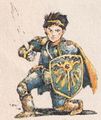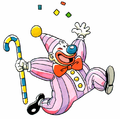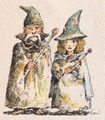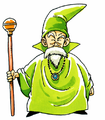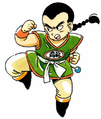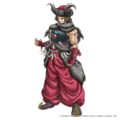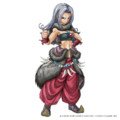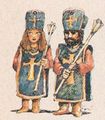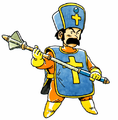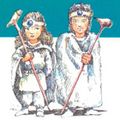List of vocations in Dragon Quest III
The vocations system was first introduced to the series in Dragon Quest III: The Seeds of Salvation, laying down the blueprint that all other versions of the system would derive from. At its core, a vocation in III defines the whole of a character in that their stat growth and spells learned (if any) are predetermined via their profession. The player can customize their characters via changing vocation or applying stat-boosting seeds, and in the remake of the game utilizing the personality system.
Assigning vocations[edit]
A character is created at Patty's Party Planning Place, where the player will be promoted to enter their name, sex, and desired vocation. All vocations can be chosen from aside from the sage and hero.
Changing vocations[edit]
The player can change a character's vocation upon reaching Alltrades Abbey and speaking with the abbot. There is no prerequisite for changing into any of the basic vocations, but doing so will drop a character back to level 1 with their stats cut in half. Any spells learned prior to this are kept however, which allows patient players to create warriors with a full repertoire of mage spells and martial artists who know all priestly spells, or simply create a character who maxes out several stats very quickly.
The vocations[edit]
Hero (勇者, Yuusha): The Hero is the most powerful of the vocations and is restricted to the main character, being a magical knight with high attack, defence, decent agility, and powerful magic at the cost of low MP. He or she can be equipped with either heavy or light armor, and can use a variety of weapons in addition to the legendary equipment reserved solely for them. The Hero also is given a variety of both offensive and defensive spells. Some of the most powerful healing, defensive, and offensive spells in the game are exclusive to the Hero, including Kaclang, which makes the party completely invulnerable for a short time, Omniheal, which completely restores the group's HP, and the lightning spells Zap and Kazap. The draw back is that the hero suffers very poor MP growth, making these naturally expensive spells even more costly to use.
Only the protagonist can be a Hero, and the player will be scolded if they attempt to change vocations.
Gadabout (遊び人, Asobinin): Gadabouts, although pretty much useless on the battle field, have a great amount of luck. This allows them to ignore the effects of debilitating spells such as snooze or dazzle much more often than other characters. The trade-off for this is the fact that Gadabouts have minds of their own, and the player cannot always control their actions. Gadabouts are the wild cards of the game, as they sometimes do damage to themselves instead of attacking enemy characters or waste a turn by goofing off. Gadabout is the only vocation that can turn into a Sage at Alltrades Abbey without any assistance, provided they are at level 20 or higher.
Mage (魔法使い, Mahoutsukai): Mages specialize in destructive magical spells such as Frizz and Boom, as well as vital support spells such as Kabuff. Mages also have access to exploration magic such as Evac and Peep, which will help the player make a quick exit from dungeons and avoid dangerous Mimics. The Mage also has the Hocus Pocus spell introduced in Dragon Quest II, which has a large menu of possible random effects: some very good, some very bad. Though Mages have high Wisdom, they are physically frail and cannot equip heavy weapons such as swords, axes, spears, or heavy armor.
Martial Artist (武闘家, Butouka): Martial artists have a great amount of agility and strength. They can deal devastating amounts of damage from a single strike, but are limited to a very small number of weapons. However, if equipped with a sword or other bladed weapon, a Martial artist's attack will actually decrease. This is because Martial artists prefer to attack with their bare hands, and so only claw type weapons will make their attack power rise. Armor for a Martial Artist is limited to lightweight tunics and clothes, and they can only equip one shield in the remake and its ports.
Merchant (商人, Shounin): Merchants have the ability to pick up additional gold after a battle. The amount of gold is dependent on the type of monsters which were defeated. Merchants can also appraise items free of charge. In battle, merchants are only average in attack and defense, slightly better than a Priest. They have access to a decent amount of armor and weapons, including abacuses which were added in the remakes, which are unique to them. In the remakes, merchants have two unique outside abilities: Dig (which allows the player to dig underfoot for treasure) and Service Call, which summons a shopkeeper in the field.
Monster Wrangler (まもの使い, Mamono Tsukai): Monster wranglers were added in the 2024 HD-2D remake of the game. They are barbarians who have learned to walk on the wild side and can mimic the abilities of monsters, leading to a bag of tricks that can handle a variety of situations. Having a Monster Wrangler in the party also makes it much easier to recruit beasties for the Monster Arena.
Priest (僧侶, Souryo): Priests are on the other side of the magical spectrum from Mages, as they specialize in healing and debilitating spells rather than attack magic. Debilitating spells such as Sap and Kasap are useful in the early stages of the game and remain so for the whole adventure. Like Mages, Priests cannot equip heavy armor, but they can use some bladed weapons much like a Hero or a Warrior can. Priests do have initially more strength, agility and vitality than Mages.
Sage (賢者, Kenja): The magical abilities of a Sage are comprised of the spells belonging to both Priests and Mages as well as boasting better HP and durability than either. This class is not initially available, but a player can transform a leveled up Gadabout into one at Alltrades Abbey once the goof off reaches level 20. If the player has a rare item called the Words of Wisdom, any character holding it can also become a Sage.
Thief (盗賊, Touzoku): The Thief class was added to the 1996 Super Famicom remake of the game. Thieves have average attack but high agility, making them more durable than one would first assume due to a character's defence being based on the agility stat. They have the ability to steal items at the end of a fight, and the success of an attempt is dependent on their level. In addition, they are decent combatants that can use whips and boomerangs to attack multiple enemies at once. In the field, abilities such as Eye for Distance allow the player to locate villages and nearby towns. They can be invaluable for exploring dungeons with abilities such as Padfoot to avoid monsters and Nose for Treasure, which lets the player know how many treasure chests are left.
Warrior (戦士, Senshi): A warrior focuses on high attack and defense, but at the cost of high priced equipment required to be functional. Their strength is much higher than other classes, but they suffer from relatively agility that makes their natural defence surprisingly poor. Warriors have the largest selection of weapons and armour in the game, but the downside to this is that it can become expensive to keep the warrior fully equipped upon reaching a new town.

